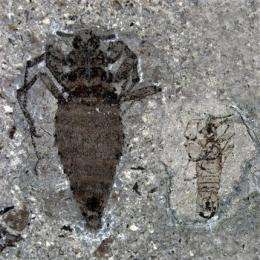Dinosaurs had fleas too -- giant ones, fossils show

In the Jurassic era, even the flea was a beast, compared to its minuscule modern descendants. These pesky bloodsuckers were nearly an inch long.
New fossils found in China are evidence of the oldest fleas - from 125 million to 165 million years ago, said Diying Huang of the Nanjing Institute of Geology and Paleontology. Their disproportionately long proboscis, or straw-like mouth, had sharp weapon-like serrated edges that helped them bite and feed from their super-sized hosts, he and other researchers reported Wednesday in the journal Nature.
Scientists figure about eight or more of today's fleas would fit on the burly back of their ancient ancestor.
"That's a beast," said study co-author Michael Engel, entomology curator at the Natural History Museum at the University of Kansas. "It was a big critter. I can't even imagine coming home and finding my miniature schnauzer with one or more of these things crawling around on it."
The ancient female fleas were close to twice the size of the males, researchers found, which fits with modern fleas.
But Engel said it's not just the size that was impressive about the nine flea fossils. It was their fearsome beak capable of sticking into and sucking blood from the hides of certain dinosaurs, probably those that had feathers.
These flea beaks "had almost like a saw running down the side," Engel said. "This thing was packing a weapon. They were equipped to dig into something."
While the ancient fleas were big, they had one disadvantage compared to modern ones: Their legs weren't too developed. Evolving over time, fleas went from crawling to jumping, Huang said.
"Luckily for the land animals of the Mesozoic, these big flat fleas lacked the tremendous jumping capacity that our common fleas have," said Joe Hannibal of the Cleveland Museum of Natural History. He wasn't involved in the study, but praised it as useful and interesting.
Just finding the fleas was a stroke of luck, Huang said. He first found one in a Chinese fossil market and mentioned it to someone at his hotel. The other guest showed him a photo of another fossilized flea, telling him it was from Daohugou in northeastern China, where there's a famous fossil bed from about 165 million years ago. Huang went there and found fleas preserved in a brownish film of volcanic ash. The grains of rock were so fine you could see antennae and other details of the fleas, he said.
Modern fleas get engorged after they feast on blood, but these didn't seem engorged, Engel said.
It shouldn't seem too surprising that there were large fleas more than 100 million years ago. If you go back even farther in time, ancestors of dragonflies and damsel flies had 3-foot wingspans, Engel said.
More information: Nature: http://www.nature.com/nature, DOI: 10.1038/nature10839
Journal information: Nature
©2012 The Associated Press. All rights reserved. This material may not be published, broadcast, rewritten or redistributed.


















